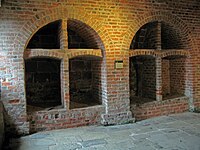Buttery (room)
– Etymology
– In the Middle Ages, a buttery was a storeroom for liquor, derived from Latin and French words for bottle or cask.
– The butler was initially in charge of the buttery before overseeing other household areas.
– The origin of the word “buttery” is complex and much written on the subject is faulty.
– The buttery was a place for serving alcohol in large houses and colleges post the dissolution of monasteries.
– The buttery was distinct from the pantry, larder, kitchen, hostelry, and dining hall.
– Location
– After the monasteries’ dissolution, the buttery in large houses and colleges stored and served alcoholic drinks.
– The buttery was situated next to the screens passage, dividing the Great Hall’s low end.
– The screens passage led to the buttery, kitchen, and pantry, forming separate household departments.
– The buttery served as a storage and serving area for wine, candles, and beer in large houses.
– In colleges like Cambridge, Dublin, and Oxford, drinks are served from the Buttery Bar.
– Function
– The primary function of the buttery in large houses was wine storage and preparation for serving.
– Candles and beer were also dispensed from the buttery to lower-ranking household members.
– The buttery often had a staircase leading to the beer cellar below.
– The wine-storage area of the buttery was usually more decorated to reflect its high-value contents.
– Today, drinks are served from the Buttery Bar in various colleges.
– Role of the butler
– The monk butterer evolved into the modern butler, in charge of the buttery and its provisions.
– In royal households, the Marshal of the Buttery was a significant post under feudal land tenure.
– In smaller households, the officer in charge of the buttery was called the yeoman of the buttery.
– With reduced household staff in great houses, the butler also served wine to the lord and guests.
– The butler was responsible for the buttery and other household areas.
– Decline
– From the mid-17th century, servants and their offices became less conspicuous and moved away from reception rooms.
– Great Halls and butteries lost their original functions and were repurposed into reception or dining rooms.
– The Great Hall often transformed into a grand staircase hall or reception hall.
– Smaller butteries and pantries were merged to create additional reception or dining spaces.
– The decline saw a shift in the use of Great Halls and butteries in large houses.
A buttery was originally a large cellar room under a monastery, in which food and drink were stored for the provisioning of strangers and passing guests. Nathan Bailey's An Universal Etymological English Dictionary gives "CELLARIST – one who keeps a Cella, or Buttery; the Butler in a religious House or Monastery." As the definition in John Stevens's The History of the Antient Abbeys shows, its initial function was to feed and water the guests rather than monks: "The Buttery; the Lodging for Guests". In a monastery a buttery was thus the place from which travellers would seek 'doles' of bread and weak ale, given at the exterior buttery door (and often via a small serving-hatch in the door, to prevent invasion of the stores by a crowd or by rough beggars). The task of doling out this free food and drink would be the role of the butterer. At larger monasteries there would also be a basic hostelry, where travellers could sleep for free.



Later the term buttery was also applied to a similar stores-room in a large medieval house, which might or might not be a cellar, and in which the buttery served the lord and his household rather than only passing travellers.
In both its uses, a buttery is to be distinguished from the butter and lard-house (pantry or larder), and the kitchen, a hostelry, or the refectory for guests or the dining hall for the inhabitants.
